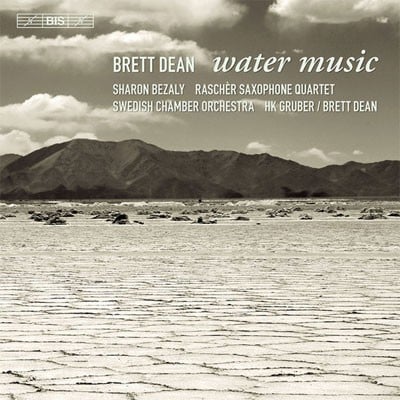soli ssax,asax,tsax,barsax; tpt-perc(4):I=tam-t/vib/timp/susp.cym(sm,lg)/glsp/SD/BD/tuned gong; II=tam-t/sizzle cym/sm susp.cym; III=crot/sm bells/med susp.cym/mark tree/med thundersheet; IV=crot/sm bells/lg susp.cym/lg thundersheet(all perc play water bowls in different sizes and water gongs)-pft(=MIDI keyboards)-strings
Abbreviations (PDF)
Bote & Bock
- Bubbling
- Coursing
- Parched Earth
Commissioned by the Swedish and Scottish Chamber Orchestras, the Badische Staatskapelle Karlsruhe and I Fiamminghi, for the Rascher Saxophone Quartet.
Thanks to Bob Scott for his assistance with the sampler programming . Thanks also to the members of the Rascher Quartet and to Australian Saxophonist Lachlan Davidson for their assistance and advice concerning aspects of saxophone technique and notation.
Water is one of the most fundamental elements of our physical world and of life on earth. It also has enormous symbolic significance in many cultures as the source and transmitter of life. We humans are indeed made up largely of water. Such is the value of water that disputes arise over its availability. Where previous wars have been fought primarily over territory, economic gain and the securing of mined resources such as oil, many predict that water itself will be at the heart of future conflict.
Water has also been much on the mind of many of my compatriots in recent times.The past few years of history-breaking drought in Australia have brought much devastation and despair across the country. It is impossible to ignore the seriousness of the scenarios that may await us, be they through war, or simply through the effects of drought and fire. Even my new home town of Melbourne, a coastal city and traditionally, even notoriously, well serviced by rainfall, has spent much of the past year employing water restrictions, with television adverts and billboards serving as constant community reminders about wise water use. Neighbourly chats about the weather have changed from that of passing curiosity to genuine concern.
Water is the inspiration for my concertante music for saxophones and chamber orchestra, jointly commissioned by a group of European ensembles to perform with the Rascher Saxophone Quartet. It was the extremely "fluid" playing style and extraordinary tonal blend of this wonderful group that initially turned my thoughts to the sounds and images of liquid as a possible starting point for this three movement work. Hearing recordings of their performances, with their unanimity of sound and virtuosity, led me to a strong desire to treat the quartet as a form of single "super-soloist", hurtling through an orchestral landscape in a series of "rapids" and "waves" of fast, flowing passage work. This then became the genesis of the second movement, Coursing.
It is in fact different aspects of water that provide the origin for each of the three movements in turn. The first movement, Bubbling, takes as its initial inspiration the sound of water. Emerging initially from the live sounds of bubbling water bowls, it finds an instrumental commentary in the toneless key sounds and pattering staccato passages of the soloists. As the movement progresses, counterparts of a more lyrical-musical nature start to surface, firstly in the orchestral strings, later via a prominent single trumpet and ultimately from the saxophone soloists themselves. One of the most striking aspects of water is its enormous potential of different purposes, be it to clean and purify, to sustain, to carry, to energise. This first movement, starting from the mere sound of bubbling water, becomes a journey into these different states and their significance.
Coursing, as previously described, is inspired by the image of rushing water, aswell as by the energetic surge of current and power that invariably lies just beneath its surface. Furthermore, on rehearsing this movement, the tenor saxophonist of the Raschers, Bruce Weinberger, wrote to me that he saw, in the suddenly quiet chorale section played by the soloists towards the end of this movement, a form of prayer for the continuation of the earth¹s future water resources, a sentiment that appeals to me strongly, while not necessarily being a conscious intention.
The final section, Parched Earth, is about the absence of water, of aridity and drought, and the fact that it dominates our lives and thoughts even more when confronted by a dangerous lack of it. This final movement then, with its stark multiphonic chords and extended trills in the solo quartet, slow string glissandi and sampled sounds of metallic eeriness, adds a deliberate question mark to the work as a whole, transforming it from a sonic celebration of one of life¹s most vital forces into a lonely soundscape of dry desert winds and bleak abandonment.
Brett Dean, February 2004
Reproduction Rights
This programme note can be reproduced free of charge in concert programmes with a credit to the composer
"Even as the instruments first come into view, a murmur ripples through the audience: a podium with a huge variety of percussion instruments and four water tanks equipped with hoses through which air is blown. Diffuse, computer-programmed sounds emanate from the keyboard and unusual techniques produce atmospheric shades from the strings and saxophones... Everything scintillates and vibrates, solidifies into a vivid body of sound, and then catapults a monstrous energy into the air. Bold rhythms roll over the music like waves... The audience was thrilled, congratulating the musicians with loud bravos." (Christine Gehringer, Badische Neueste Nachrichten, 16. Jun 2004)

Raschèr Saxophone Quartet / Swedish Chamber Orchestra / HK Gruber
BIS-CD-1576

